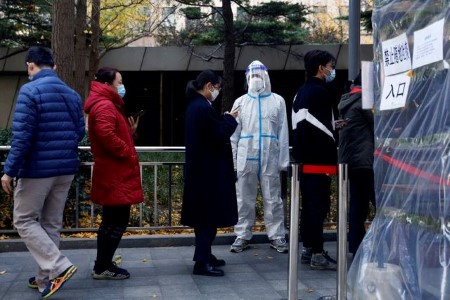




Policy Rate Updates: Double cut finale
 DOWNLOAD
DOWNLOAD

Monthly Economic Update: One for the road
 DOWNLOAD
DOWNLOAD

Inflation Update: Still low, still slow
 DOWNLOAD
DOWNLOAD


Investors ignore China Covid spike at their peril

The author is a Reuters Breakingviews columnist. The opinions expressed are his own. Updates to add chart.
By Pete Sweeney
HONG KONG, Nov 18 (Reuters Breakingviews) – The blistering relief rally underway in Chinese equities is understandable. President Xi Jinping had implemented a mixture of harsh policies targeting Covid-19, technology entrepreneurs and real estate developers that kept equity indexes in the basement and aggravated capital flight – roughly $101 billion was pulled out the country, reading between the lines of official balance of payments data for the first six months of the year. Tentative relaxations on all the main fronts have investors cheering; the Golden Dragon index .HXC of New York-listed Chinese companies is up 37% since late October. Yet biology could ruin this party yet.
Most of China’s trading partners have moved on to living with the virus, but Xi still aspires to keep it out. Unfortunately, highly contagious new strains took advantage of the travel surge during the October national holiday week to go on a tour around the country. Surveys by consultancy Dragonomics logged over 200 cities per day reporting outbreaks in November, more than double the number seen during the traumatic lockdown in Shanghai in April. New cases have officially multiplied from roughly 1,000 per day in October to 25,353 on Thursday. There are reasons to suspect the real numbers are higher. Some cities reported suspiciously low case figures which were belied by severe quarantine polices. Others want to accelerate away from zero-Covid to relieve their local economies, as the city of Shijiazhuang in Hebei tried to do, which could lead to underreporting.
Unfortunately state propaganda organs have invested two years in terrifying citizens about the virus, which means not everyone is relaxed about relaxing epidemic controls. Local media catered to conspiracy theories about foreign vaccines while pandering to the local traditional medicine industry. As a result many elderly declined to get jabbed. Partial success at containment has slowed development of herd immunity while vaccination rates have flattened.
Unless infections get tied down quickly with existing methods, there are three ugly scenarios worth considering. In the first, Beijing quarantines even more tightly. In the second, Covid-19 finally runs wild in China, killing the unvaccinated elderly as it did in Hong Kong earlier this year. Alternatively, current virus strains could turn out to be less lethal, keeping the ultimate death rate low, but having no way to know this in advance, many Chinese people would probably sequester themselves in panic anyway.
Economically, any of these scenarios could re-enact the first quarter of 2020, when GDP contracted 6.8%, wreck any relief rally and further squeeze earnings at consumer-facing companies like Alibaba and Starbucks. They will fuel unrest that has erupted on the streets and hobbled production lines at iPhone maker Foxconn 2317.TW. It was past time to revise Beijing’s approach to the pandemic, to its companies and its economy. It may also be too late.
CONTEXT NEWS
China logged 25,353 new Covid-19 infections on Nov. 17, per National Health Commission data published on Nov. 18, compared to roughly 1,000 new cases per day in mid-October. That is comparable to the high national contagion rates in April when Shanghai was forced into a draconian lockdown from the beginning of April through June.
Beijing announced minor relaxations of the country’s pandemic policy on Nov. 11, including shorter quarantine periods and more narrowly targeted lockdowns.
The Hang Seng China Enterprises Index in Hong Kong has risen nearly 30% in the past 14 trading days, Refinitiv data show, while the onshore benchmark CSI300 index gained 9%. The yuan has also firmed slightly against the dollar after an extended period of decline.
(Editing by Una Galani and Katrina Hamlin)
This article originally appeared on reuters.com





 By Reuters
By Reuters